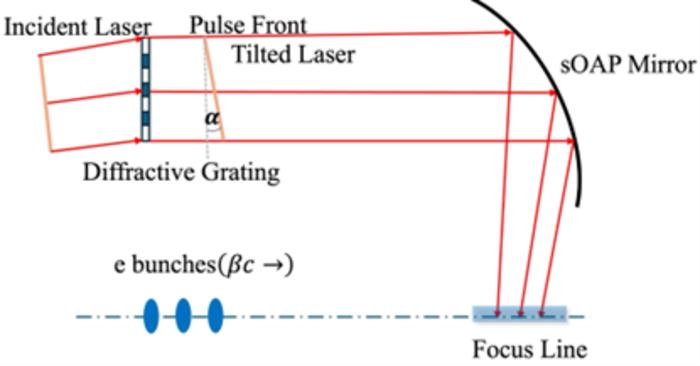In a groundbreaking study recently published in Nuclear Science and Techniques, researchers have introduced a pioneering method for generating structured light that could revolutionize the field of high-intensity photon sources. Traditional laser systems focus light onto a single point; however, this novel approach not only redefines the way light is managed but opens up new possibilities within various scientific and technological applications. The research team’s innovative scheme involves engineering a laser beam to create a continuous string of focal spots, reminiscent of a series of pearls strung along a line. This transformation fundamentally alters the dynamics of light interaction with matter, particularly in coherent scattering processes.
The methodology leverages a specialized type of mirror known as the stretched off-axis paraboloid (sOAP) mirror. The sOAP mirror is an essential component in this new lighting scheme since it facilitates an extended focal range while maintaining precise control over the periodic light field. By utilizing the “focal string” technique, researchers can create an arrangement of focal points over several centimeters, aptly designed to correspond with high-energy electron beams. This remarkable feat not only showcases advanced optical engineering but also aligns with the increasing demands for sophisticated light sources in scientific applications.
As the research advances, the implications of this coherent scattering technique become increasingly significant. Coherent inverse Compton scattering — the phenomenon harnessed by the research team — arises from the combination of this periodic structured light with electron beams that can be precisely formatted into microbunched states. During interaction, the carefully arranged array of focal spots interacts with these microbunched electrons, leading to enhanced levels of coherent scattering. Unlike traditional methods, where captured intensity is proportional to the product of the number of electrons and photons (N1×N2), this new scheme elevates the interaction such that intensity scales with the square of that product (N1×N2)², amplifying the effectiveness of photon generation dramatically.
The significance of achieving higher-intensity scattered photon beams cannot be underestimated, especially in critical applications across multiple domains such as synchrotron radiation, material sciences, and even potential medical technologies. According to Academician Yugang Ma, who helms the research team, the growing demands for advanced light sources, particularly those in the extreme ultraviolet (EUV) and soft X-ray ranges, underline the urgency for innovations in this space. The success of this coherent Compton scattering approach could represent a crucial breakthrough, providing intensified sources of radiation that promise to surpass existing technologies, meeting the needs of both industry and scientific exploration.
Further emphasizing the importance of this research, Professor Changbo Fu pointed out the historical context of coherent scattering processes in physics, highlighting their pivotal roles in advancing science and technology. The potential developments stemming from coherent inverse Compton scattering could lead to profound enhancements not only in the understanding of fundamental physics but also in practical applications. The anticipated outcomes may pave the way for novel light sources that can deliver performance improvements in various fields, thus benefiting diverse sectors of society.
Additionally, the engineering behind structured light generation that maintains a consistent focal region is an exciting leap forward in optical physics. With the capability to produce a regularly distributed string of focal points, this technology empowers researchers and technological innovators to access advanced forms of photonic interactions that were previously unattainable. Enhanced performance across an array of potential applications holds exceptional promise for fields ranging from material analysis to bioimaging, with high-intensity soft X-ray and EUV sources featuring prominently.
The rigorous experimental studies conducted by the research team have set a solid foundation for future investigations into coherent scattering mechanisms. The combination of high precision optical design with creative engineering solutions signals a bright future for researchers looking to leverage these enhanced photon sources effectively. As they delve deeper into this complex topic, the team expects to uncover further applications that can capitalize on the unique benefits provided by structured light and the innovative properties of coherent scattering.
Researchers are encouraged to keep track of developments stemming from this study, as continuous enhancements in technology will inspire new applications for high-intensity photon sources and collaborative advancements within scientific communities. The momentum generated by this research is expected to propel the fields of nuclear and particle physics toward groundbreaking discoveries and novel technologies that could vastly improve our understanding of the universe and enhance practical innovation across multiple industries.
The complete details of the research are documented in the peer-reviewed journal, Nuclear Science and Techniques, available for public access through its DOI. The study not only opens doors to future innovations but also holds a critical place in the ongoing discourse surrounding high-intensity generation of coherent light, ultimately contributing to the broader narrative of progress within scientific research.
In conclusion, the research team’s findings represent a significant leap forward in the quest for developing high-intensity light sources and applying coherent inverse Compton scattering techniques. The systematic exploration of structured light and innovative methods signals a transformative era in both the scientific understanding of coherent interactions and the technological applications derived from such principles. This study is poised to inspire further research and development, ensuring that high-intensity light sources will continue to evolve, meeting the challenges of the future head-on.
Subject of Research:
Article Title: Coherent Compton scattering using a stretched off-axis paraboloid
News Publication Date: 26-Jun-2025
Web References:
References:
Image Credits: Credit: Chang-Bo Fu
Keywords
Coherent scattering, structured light, Compton scattering, extreme ultraviolet, soft X-ray, optical engineering, high-intensity light sources.




